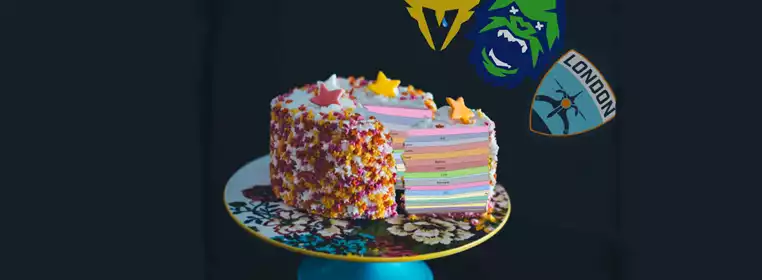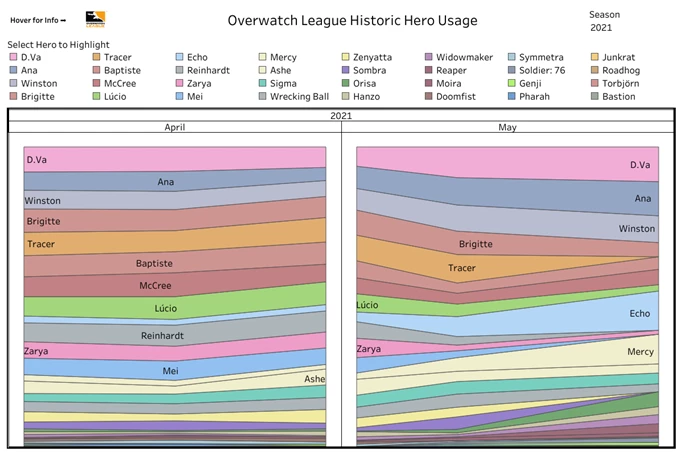Four Tasty Developments In The Overwatch League You Should Keep Track Of

A third of the Overwatch League regular season has been played. Slowly but surely, new patterns are emerging, revealing the character of this season and its many storylines, which have contributed towards an uptick in viewership. Some of those patterns are exciting and add to the flavour of the experience; others may be concerning for your enjoyment of future matches. Keeping a finger on the pulse of those developments might just be the way to make sense of the chaos. Here are five major developments of the Overwatch League that may lend insight into the nature of Overwatch as a game, the league’s new structure, what we enjoy, and the cycle of sucking. Incentives have shifted big time, and it’s likely to change the strategy of how teams approach future seasons.
Teams get what they paid for
Take a glance at the cellar of the regular season standings so far this season, and the pattern should be fairly obvious. The Titans, Valiant, and Spitfire are all likely to be close to the minimum amount of spending on salaries and buyouts possible. Mind you, these two values are not the end all be all of spending, with money going into team infrastructure being an important part of the equation too.
While we knew that it was the worst season to be a bad team in the Overwatch League yet, we likely even underestimated some of the effects of being a bad team. Consider the following: The current leader of the Overwatch League standings, the Shanghai Dragons, have played 11 hours of in-game time so far this season as per Statslab. By comparison, the London Spitfire have played 5.5 hours, and the gap is likely to widen further if the Dragons were to make it far in the June Joust tournament. Worse yet, if the Los Angeles Valiant were to be beaten at a similar pace as they were by the NYXL last week, they’d be at around 4.5 hours at the mid-season point while the Dragons could see up to 14 hours of playtime after June Joust concludes. Therefore our estimate of exposure with the difference between the best and the worst team being a factor of two undershot the severity of air time. Three times as much play time over the entire season to attract loyal fans does not seem impossible when also factoring in the season playoffs.
One can at least begin to wonder if strategies with an overall low amount of spending actually are the highest expected value plays for those teams, and, if they were, what the implications of those realities are.
3-0verwatch might be coming back
While the pattern isn’t particularly strong at this point in the season, there appears to be a palpable feeling of more matches turning into absolute blowouts. Not only have two of the three fastest matches in the history of the Overwatch League taken place in the destruction of the Titans and the Valiant respectively last week, the amount of clean sweeps has also been slowly increasing, closing in on the 50% mark of all match scores which we’ve so often met last season. While we only had four out of the 14 matches end in 3-0s, the rate has been creeping up to six out of 14 in the fifth and sixth week of the regular season.
More interesting, albeit speculative, are the potential reasons for the increasing amount of one-sided matches. Of course, we can expect that many or most of these blowouts will come from the clearly worst teams in the league. Shaping perception into reality, decreasing confidence, churn of continuous losses, and likely a steady decline of the quality of practice partners these perceived worst teams would get added to the depth of the hole teams like the London Spitfire, Los Angeles Valiant, and Vancouver Titans are trying to climb out of. On the flipside, Paris Eternal, Boston Uprising, and Guangzhou Charge might have given themselves not only a countable victory on their scoreboard but also the mental boost of being able to punch up and see the fruits of their labour. If there is anything to this theory, not having been beaten into submission in week 1 of this cycle could’ve kept us from a much higher amount of 3-0verwatch than we are used to from previous years, giving the idea of a season of parity a fighting chance. Credit where credit is due, it might be down to hero pools soft resetting hierarchies that will give us a more competitive season.
The meta is a cake
Looking at stats lab's distribution of hero play data, we notice that we have a much more evenly layered rate than in previous seasons with less frequent hero pools. Within a tournament cycle (which also serves as a marker for hero pools and balance changes), it appears that not too many changes in the distribution of heroes played. However, that doesn’t necessarily mean that it’s dull but rather that many teams either find out what the preferred meta is fairly soon or figure out their flavour, which they will want to play for the remainder of it.

 Click to enlarge
Click to enlargeFor the longest time, we’ve thought about metas as a selection of the same ingredients by the most skilled confectioners baked into a cake. As soon as a new cycle rolls around, bakers around the league nervously take their creation out of the oven and make the first slice in week 1 to check how well their cake turned out. For teams like Washington Justice, the difference between trying their hands on a delicate red velvet cake and a sponge cake seems night and day. Just like that, they can go from an impressive 4-0 in one cycle to one of the worst-performing teams in the West.
Other teams have taken a page out of Chengdu’s cookbook and have made a selection of whatever they have left in the pantry. If the meta is a cake, teams like the Dallas Fuel have impressively shown us that it is a lie. Be it meta flavour or colour; this season has so far highlighted a truth that been bubbling up under the surface for the longest time and was likely true at any given point in the history of competitive Overwatch: You will play your best Overwatch if you choose the ingredients your team can handle instead of trying to copy cat the best team’s selection of their best selves.
Up and Down - Full Circle
With the emergence of the Houston Outlaws and the Dallas Fuel, the vast majority of teams have now experienced life at the top and the bottom of the league standings at some point in their Overwatch League history. Notable exceptions from the cycle of hero to zero or vice versa are the Philadelphia Fusion, who were never truly a bottom tier team and the Toronto Defiant, who never enjoyed more than a stage at the third of the standings.
Looking at the top 5 teams of the regular season standings as they are right now, it would be almost comical to show those to fans who stopped watching after the conclusion of season 1 with the table of the Shanghai Dragons, Florida Mayhem, Dallas Fuel, San Francisco Shock, and Houston Outlaws now flipped on its head in season 4.
Conversely, the big winners of past seasons like the New York Excelsior, London Spitfire, Vancouver Titans but also strong teams of last season in the Guangzhou Charge and the Paris Eternal find themselves on the other side of the rankings.
Searching for likely explanations for this rotation of good to awful and back proves difficult. One theory we could entertain is that for some owners, being a top team didn’t pan out financially as they hoped it would, asking themselves why they would spend on high salaries to maintain their roster. By the same theory, the same monetisation issue could be true for bottom-tier teams, giving them incentives to invest into the success of their team after having seen the effects of their previously low spending strategy. Of course, this isn’t true for every team, with the Dallas Fuel appearing to be a notable exception.
Perhaps, organisations resetting themselves is a pattern that will follow us in the future unless significant incentive changes stabilise the system in meaningful ways. Until then, holding on to your favourite team until it eventually becomes one of the best looks to be backed up by Overwatch history.
Images via Blizzard Entertainment
